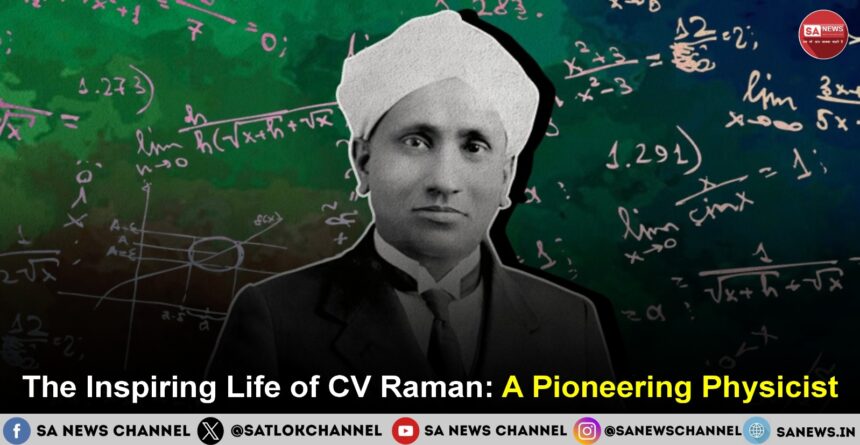Chandrasekhara Venkata Raman was a famous Indian physicist. He made a big impact on science. His work, like the Raman effect, won him the Nobel Prize in Physics in 1930.
- Key Takeaways
- Early Life and Background of CV Raman
- Educational Journey and Academic Excellence
- Professional Career and Scientific Pursuits
- Financial Service and Dedication to Science
- Appointment at the University of Calcutta
- Research Environment and Scientific Collaborations
- The Discovery of the Raman Effect: A Scientific Breakthrough
- The Inspiration Behind the Research
- Experimental Process and Challenges Overcome
- The Moment of Discovery and Its Scientific Significance
- Nobel Prize and International Recognition
- The Historic Nobel Prize Achievement (1930)
- First Asian Scientist to Receive the Physics Nobel
- Global Scientific Accolades and Honors
- Contributions of CV RAMAN to Physics and Beyond
- Raman Spectroscopy: Principles and Revolutionary Applications
- Research in Acoustics, Optics, and Crystal Dynamics
- Scientific Publications and Lasting Impact on Modern Science
- Building India’s Scientific Legacy
- Founding the Raman Research Institute in Bangalore
- Mentorship and Inspiring Generations of Indian Scientists
- Later Years and Personal Philosophy
- Family Life and Personal Interests
- Scientific Work in Later Years
- Philosophical Approach to Science and Life
- Conclusion: The Enduring Legacy of a Scientific Visionary
- FAQ
- Who was CV Raman and what were his major contributions to physics?
- What is the Raman Effect?
- What is Raman spectroscopy and how is it used?
- What awards and honors did CV Raman receive for his work?
- What is the significance of CV Raman’s work in modern science?
- What institutions did CV Raman found or contribute to?
- How did CV Raman’s early life and education influence his scientific career?
His story shows how important curiosity and hard work are. Born in India, Raman loved science from a young age. This love led him to make big changes in physics.
Key Takeaways
- The life and achievements of Chandrasekhara Venkata Raman serve as a source of inspiration.
- Raman’s work had a profound impact on our understanding of physics.
- His discovery of the Raman effect was a key moment in science history.
- Raman’s legacy continues to inspire scientists worldwide.
- His contributions to physics are unmatched.
Early Life and Background of CV Raman
CV Raman was born in a place known for its rich culture. His early life mixed old traditions with new scientific interests. He was born in Trichinopoly (now Tiruchirappalli), Tamil Nadu, India. This place was full of learning and discovery.
Birth and Family Heritage in Tamil Nadu
CV Raman was born on November 7, 1888. His parents were Chandrasekaran Ramanathan Iyer and Parvathi Ammal. His dad taught math and physics at a college.
This made their home a place of learning. His family’s love for knowledge helped shape his future.
Childhood Curiosity and Early Scientific Inclinations
Raman was always curious as a child. He loved to ask questions and do simple science experiments. His parents supported his curiosity, seeing his great interest in science.
As he got older, his love for physics grew. This set him on the path to becoming a famous Indian physicist. He would later discover the Raman Effect.
Educational Journey and Academic Excellence
CV Raman’s journey in education was all about seeking knowledge and loving science. His hard work and dedication showed in his achievements.
Remarkable Academic Achievements at a Young Age
Raman showed his smartness early on. He finished his matriculation at 11 and got into Presidency College, Madras, at 13. His academic excellence was noticed from the start.
At Presidency College, he shone in physics and math. He understood complex ideas well. His early success paved the way for his later achievements.
University Education and Early Scientific Pursuits
Raman started his university life at Presidency College, graduating with honors in physics. He then got his master’s at the University of Madras. This helped him build a strong base for his research.
At university, he learned about many scientific fields. This sparked his interest in Raman spectroscopy. He would later make big contributions to this area.
Also Read: The Man Who Knew Infinity: Srinivasa Ramanujan
His early research was driven by curiosity. He explored physics and laid the groundwork for his Nobel Prize-winning discovery, the Raman Effect.
Professional Career and Scientific Pursuits
CV Raman’s career was a mix of finance and science. He worked in finance but always loved science.
Financial Service and Dedication to Science
Raman started working in 1907 in Calcutta’s Finance Department. He worked hard in finance but also loved science. He spent his free time on science, setting the stage for his big discoveries.
Appointment at the University of Calcutta
In 1917, Raman became the Palit Professor of Physics at the University of Calcutta. This job let him focus more on science. It was a big change in his career, helping him dive deeper into science.
Research Environment and Scientific Collaborations
The University of Calcutta was great for Raman’s research. It had a good environment for science and let him work with other scientists. His work showed his curiosity and dedication to science.
| Year | Position/ Achievement | Institution |
| 1907 | Deputy Accountant General | Finance Department, Indian Civil Service |
| 1917 | Palit Professor of Physics | University of Calcutta |
Raman’s work at the University of Calcutta was key to his success. His collaborations and the research environment helped him make important discoveries, like the Raman Effect.
The Discovery of the Raman Effect: A Scientific Breakthrough
CV Raman’s work led to the Raman Effect discovery. This is a big scientific find. It shows how light changes when it hits molecules.
The Inspiration Behind the Research
Raman was curious about the sea’s blue color on a ship to Europe in 1921. This sparked his interest in light scattering. He started studying how light interacts with molecules.
The inspiration for his research was his observations. They made him wonder about light and matter.
Experimental Process and Challenges Overcome
Raman and KS Krishnan used a mercury lamp and a spectrograph for their experiments. They faced challenges like the faintness of the effect. They needed precise tools.
The experimental process was very detailed. They worked hard to find and measure the Raman Effect.
The Moment of Discovery and Its Scientific Significance
On February 28, 1928, Raman and Krishnan saw the Raman Effect. They noticed the scattered light’s wavelength changed. This was a big find.
The Raman Effect has changed physics and chemistry a lot. It helps us study molecular structures. It has led to many new discoveries.
Nobel Prize and International Recognition
Chandrasekhara Venkata Raman won the Nobel Prize in 1930. This was a big win for Asian scientists everywhere. His discovery of the Raman Effect helped us understand light and matter better.
The Historic Nobel Prize Achievement (1930)
CV Raman got the Nobel Prize in Physics in 1930. He discovered the Raman Effect, where light scatters off molecules. This changed how we see light and matter.
The Raman Effect is now key in physics and chemistry. It helps us study molecular structures.
First Asian Scientist to Receive the Physics Nobel
Raman’s win was a big deal. He was the first Asian to get the Nobel Prize in Physics. This opened doors for other Asian scientists.
Global Scientific Accolades and Honors
CV Raman got many awards from scientists all over. Here are some of them:
| Award/Honor | Year | Institution/Country |
| Nobel Prize in Physics | 1930 | Sweden |
| Knighthood | 1929 | United Kingdom |
| Bharat Ratna | 1954 | India |
CV Raman’s work was recognized worldwide. His legacy keeps inspiring scientists everywhere.
Contributions of CV RAMAN to Physics and Beyond
CV Raman’s work in physics is truly groundbreaking. His research has deepened our understanding of the world. It also led to many new technologies.
Raman Spectroscopy: Principles and Revolutionary Applications
Raman spectroscopy was discovered by CV Raman. It’s a key tool in science today. It shows how molecules vibrate and move by scattering light.
This method has revolutionized how scientists study materials. It lets them check what something is made of without touching it.

Research in Acoustics, Optics, and Crystal Dynamics
CV Raman’s work went beyond his famous discovery. He also made big contributions to acoustics, optics, and crystal dynamics. His studies showed his deep understanding of physics.
He was able to explore many scientific areas. This shows his wide range of knowledge.
Scientific Publications and Lasting Impact on Modern Science
CV Raman was a busy publisher. His papers are often cited today. They not only shared his findings but also inspired others.
His work’s impact is clear in today’s science and tech. His discoveries, like Raman scattering, keep influencing research.
CV Raman’s legacy in physics is clear. His discoveries have shaped science and technology. His work continues to inspire and guide today’s scientists.
Building India’s Scientific Legacy
CV Raman’s work helped make India a strong place for science. He wanted to create a system where research could grow on its own. His efforts helped shape India’s role in science.
Founding the Raman Research Institute in Bangalore
In 1948, CV Raman started the Raman Research Institute (RRI) in Bangalore. This move greatly helped India’s science community. The RRI let Raman do his research and helped other scientists too. Today, the RRI is a top research center, making big contributions to science.
Mentorship and Inspiring Generations of Indian Scientists
Raman was not just a great scientist but also a caring mentor. He loved helping young minds explore science. At the RRI, he gave young scientists a chance to do groundbreaking work.
His work at the RRI keeps inspiring Indian science today. Raman’s work in building science infrastructure and mentoring scientists has made a lasting impact on India.
Later Years and Personal Philosophy
CV Raman’s later years were filled with great science contributions and deep thought. His personal life and beliefs greatly shaped his legacy.
Family Life and Personal Interests
CV Raman, or Chandrasekhara Venkata Raman, loved his family a lot. He was married to Lokasundari Ammal and had many children. His family enjoyed music and art, showing his diverse interests.
Raman loved classical Indian music. He often played music at home with friends.
Scientific Work in Later Years
CV Raman kept working on science even when he was older. He studied many physics topics, including the Raman Effect. This work made him famous worldwide.
He founded the Raman Research Institute in Bangalore. It showed his dedication to science.
Philosophical Approach to Science and Life
Raman saw science as very important. He thought it could show us the universe’s secrets. His views were shaped by Indian spirituality and the idea that everything is connected.
He wrote and spoke about science’s big picture. His ideas were deep and thought-provoking.
| Aspect | Description |
| Family Life | Strong family bonds, appreciation for music and art |
| Scientific Contributions | Continued research, exploration of physics, Raman Effect |
| Philosophical Outlook | Influenced by Indian spirituality, belief in interconnectedness |
Conclusion: The Enduring Legacy of a Scientific Visionary
CV Raman’s life and work inspire many scientists and researchers. He was an Indian physicist who made a big discovery. This discovery, the Raman Effect, won him the Nobel Prize in Physics in 1930.
He also developed Raman spectroscopy. This technique changed physics and chemistry. It helps scientists learn about molecules and materials.
Raman’s impact goes beyond science. He helped shape India’s science scene. He founded the Raman Research Institute in Bangalore and guided many young scientists.
Today, Raman spectroscopy is key in science. It’s used in many areas, from materials science to health research. CV Raman’s work keeps inspiring scientists, showing his lasting impact.
FAQ
Who was CV Raman and what were his major contributions to physics?
CV Raman was an Indian physicist. He discovered the Raman Effect, winning the Nobel Prize in 1930. His work started Raman spectroscopy, a key tool in science.
What is the Raman Effect?
The Raman Effect happens when light scatters in a material. This scattering changes the light’s wavelength. It shows what’s inside the material, like its molecules.
What is Raman spectroscopy and how is it used?
Raman spectroscopy uses the Raman Effect to study materials. It shows the molecular structure of substances. Scientists use it in chemistry, biology, and materials science.
What awards and honors did CV Raman receive for his work?
CV Raman won many awards, including the Nobel Prize in 1930. He was the first Asian to win in physics. This was a big moment for science in Asia.
What is the significance of CV Raman’s work in modern science?
CV Raman’s work, like the Raman Effect, changed science. It lets us study materials at a molecular level. This has helped many scientific fields grow.
What institutions did CV Raman found or contribute to?
CV Raman founded the Raman Research Institute in Bangalore, India. It’s a center for science, showing Raman’s dedication to research.
How did CV Raman’s early life and education influence his scientific career?
CV Raman’s early life in Tamil Nadu and education shaped his career. His family and school encouraged his science interests. This led him to become a famous physicist in India.









